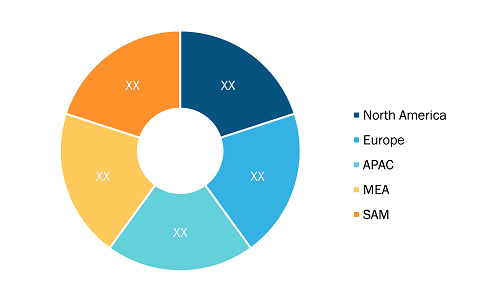According to our latest research study on “Lithium-ion Battery Energy Storage Market Forecast to 2028 – COVID-19 Impact and Global Analysis – by Connection Type, End-use, and Capacity,” the market is expected was valued at US$ 7,972.80 million in 2022 and is expected to reach US$ 26,224.37 million by 2028; it is estimated to register a CAGR of 13.9% from 2023 to 2028.
A network of decentralized, medium-scale power-generating units, such as wind farms, solar parks, combined heat and power plants, and adaptable power consumers and storage devices, makes up a virtual power plant (VPP). Depending on the market setting, VPPs can carry out various tasks. A virtual electrical grid connects hundreds or even thousands of households and forms the backbone of a virtual power plant. Many homes might have already installed solar panels and energy storage systems. For backup purposes, a virtual power plant can use BESS together. It can be utilized when there is a need to remove extra power from the grid. Growing era of VPP is expected to have a lucrative impact in the lithium-ion battery energy storage market growth.
Lithium-ion Battery Energy Storage Market Share – by Region, 2022
Lithium-ion Battery Energy Storage Market Forecast to 2028 - Global Analysis By Capacity (0-10 kW, 10-20 kW, 20-50 kW, and Above 50 kW), Connection Type (On-Grid and Off-Grid), and End-use (Residential, Commercial, and Industrial, and Utility)
Lithium-ion Battery Energy Storage Market Report – Size & Forecasts 2028
Download Free Sample
Various organizations across the globe are focusing on modernizing their energy storage systems by developing innovative ways such as VPP to increase grid resilience, considering cases of extreme weather. For instance, in February 2021, the emergence of Winter Storm Uri caused one of the most extensive blackout periods in the US. In addition, a set of BESS deployed at various residential or smaller complex sites is combined to create virtual power plants. This accumulated, stored energy from various distributed resources can be used to strengthen the grid's resilience. Without primarily relying on the US infrastructure investment in new transmission lines, virtual power plants might assist utilities in supplying consistent and dependable power to their customers.
Asia Pacific is one of the leading regions in the lithium-ion battery energy storage market, owing to favorable government policies and a rise in investment in wind and solar energy projects. Countries such as India, China, and Japan are the dominating countries holding a major lithium-ion battery energy storage market share, which is further expected to increase during the forecast period. According to China’s National Energy Administration (NEA), solar and wind power output increased by 21% and reached 1,190 TWh in 2022. This accounted for 13.8% of the total power consumption of China, which is approximately equal to the consumption of all urban and rural households. In addition, the supportive government policies are further expanding the installation of renewable energy capacity. According to the State Council of the People’s Republic of China, in 2022, China added total capacity of 125 GW in solar parks and wind farms combined, reaching a total capacity of 1,213 GW, of which photovoltaics accounted for 87.4 GW.
Impact of COVID-19 Pandemic on Lithium-ion Battery Energy Storage Market
The region witnessed a decline in economic activity and energy consumption due to the social isolation and lockdown measures implemented in many countries, which has led to a decline in the demand for energy storage during the COVID-19 pandemic and impacting the overall lithium-ion battery energy storage market growth. On the other hand, the pandemic has moderately affected the residential energy storage business since many homeowners have opted for solar panels and battery storage to reduce their reliance on the grid. The pandemic has affected manufacturing and logistics, which has led to delays and shortages of raw materials and components in the supply chain. Despite these obstacles, the European Commission has unveiled a new plan to aid in the growth of a competitive and sustainable battery industry in Europe. For instance, in February 2021, Spain released its Energy Storage Strategy with a deployment goal of 20 GW of behind-the-meter and grid-scale storage by 2030. In Germany, many innovation auctions promote combining renewable energy with storage.
The lithium-ion battery energy storage market size is segmented on the basis of connection type, end-use, capacity, and geography. Based on connection type, the lithium-ion battery energy storage market is bifurcated into on-grid and off-grid. Based on end-use, the lithium-ion battery energy storage market is categorized into residential, commercial and industrial, and utility. Based on capacity, the lithium-ion battery energy storage market is classified into 0-10 kW, 10-20 kW, 20-50 kW, and above 50 kW. The lithium-ion battery energy storage market size, based on region, is segmented into North America, Europe, Asia Pacific (APAC), and the Rest of the World (RoW).
LG Chem Ltd.; CATL; Samsung SDI; Panasonic Corporation; and BYD Co., Ltd. are among the key lithium-ion battery energy storage market players operating in the industry. During this study, several major lithium-ion battery energy storage market players were analyzed to get a holistic view of the global market and its ecosystem.
Contact Us
Phone: +1-646-491-9876
Email Id: sales@theinsightpartners.com